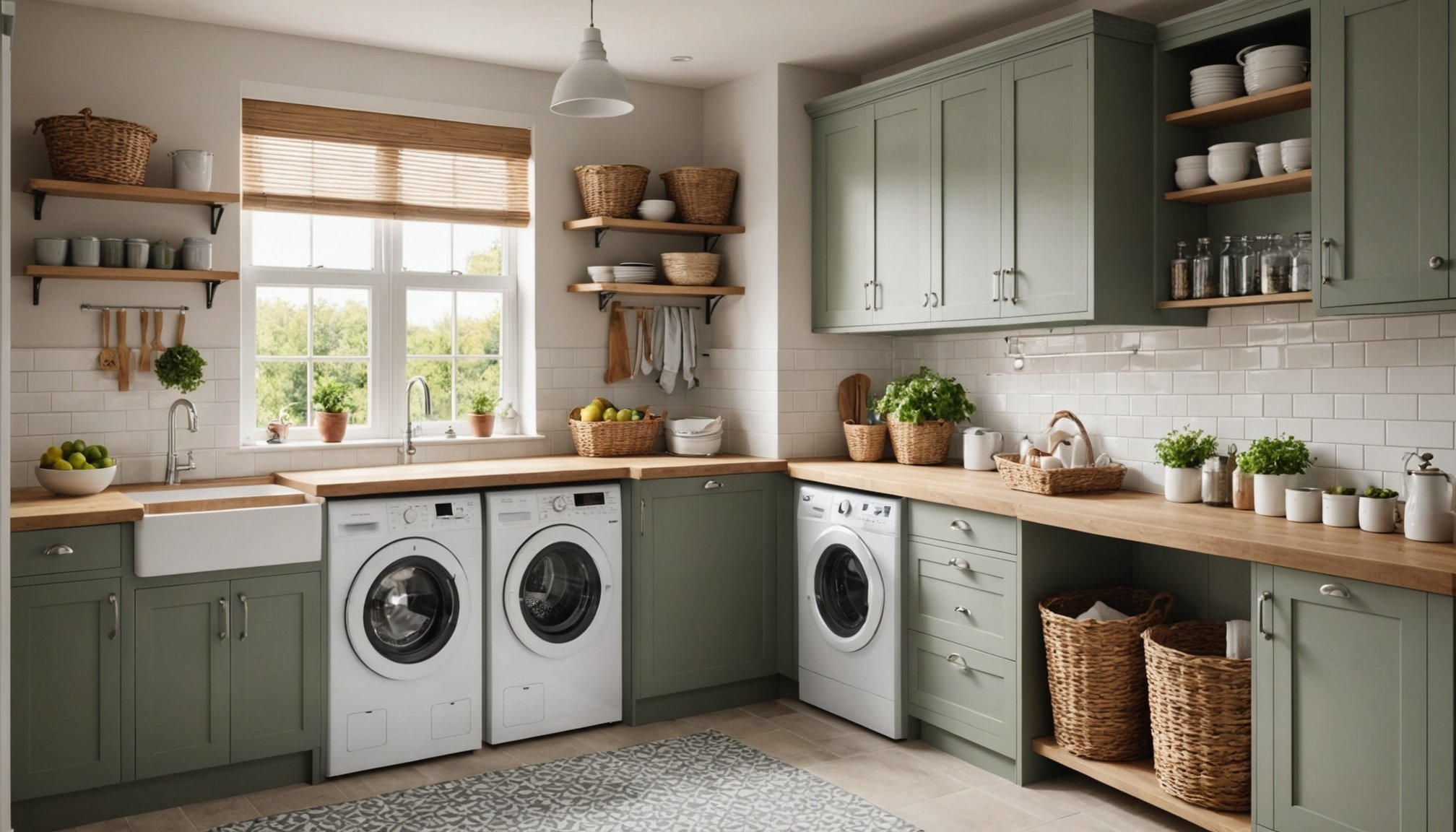Introduction to Integrating Laundry Spaces in UK Kitchens
Modern living in the UK often requires maximising space efficiency within homes, leading to the innovative trend of combining laundry and kitchen spaces. This approach is especially popular due to limited space in many UK homes, compelling homeowners to optimise every corner. A well-integrated design not only meets functional needs but maintains an aesthetic appeal, ensuring that the kitchen remains a welcoming and efficient hub.
The UK kitchen design strategy focuses on seamless incorporation of laundry appliances, often tucked away behind cabinetry, preserving the kitchen’s visual harmony. Solutions include stacking appliances, such as washers and dryers, to save on floor space, or opting for compact models designed for restricted areas. Functionality doesn’t have to be compromised for style; rather, balanced integration allows the utility of a laundry space to complement the overall kitchen look.
En parallèle : Brightening Up: Innovative Strategies to Maximize Natural Light in Your UK Basement Conversion
Laundry in kitchens necessitates thoughtful planning—consideration of factors like ventilation, drainage, and noise must be taken into account to ensure a smooth operation. As homes continue to shrink, aligning domestic tasks within a shared space becomes not only a trend but an essential strategy for efficient living.
Creative Design Tips for Incorporating a Laundry Area
The concept of integrating a laundry area within a kitchen design is gaining popularity in the UK. This approach harmonises functionality with aesthetics, following contemporary UK kitchen trends. One effective idea is to utilise specially designed cabinetry. This method allows for laundry appliances, like washing machines and dryers, to be neatly concealed, maintaining a streamlined and uncluttered look.
Avez-vous vu cela : Transform Your UK Mid-Century Modern Home with the Ultimate Smart Lighting Setup
Incorporating a laundry station into a kitchen island design is another innovative solution. It maximises limited space while enhancing accessibility. This design idea offers practicality without sacrificing style, ensuring that the kitchen remains a functional and visually appealing hub.
When planning your design, consider choosing complementary colour schemes. A well-chosen palette ensures cohesiveness throughout the space. It ties the laundry area to the rest of the kitchen, creating an integrated look. Opt for neutral or subtle hues that reflect current trends and elevate the aesthetic appeal.
Experimenting with these design ideas can transform your kitchen into a versatile and stylish area. By embracing these strategies, you ensure that your laundry space isn’t just functional, but also a beautiful addition to your home.
Functional Solutions for Small Kitchens
When tackling the challenge of a small kitchen, selecting space-saving appliances and furniture is key. Slimline washing machines and dryers are excellent choices, offering efficiency in a compact size. These appliances are specifically designed to fit into smaller spaces without compromising on functionality. Look for models that maximise capacity while maintaining a small footprint.
Foldable countertops present another creative way to make the most of limited kitchen areas. These multifunctional surfaces can be expanded when needed and neatly tucked away afterwards, providing essential workspace for various tasks, including laundry. Such versatility allows you to adapt the kitchen space to your immediate needs effortlessly.
Additionally, open shelving can dramatically optimise storage. By replacing bulky cabinets with open shelves, you not only save space but also create a sense of openness. This approach makes items more accessible while encouraging you to stay organised. Utilising vertical space along walls, these shelves can hold everything from cookware to decorative elements, cleverly combining function and aesthetics.
Incorporating these innovations into your kitchen can make even the smallest areas highly effective and stylish, encouraging a seamless and enjoyable cooking experience.
UK-Specific Considerations
In the UK, plumbing regulations play a significant role when installing kitchen appliances. It’s crucial to familiarise oneself with the Water Supply (Water Fittings) Regulations to ensure compliance. These stipulate that any plumbing work must prevent water wastage and contamination. Understanding these requirements helps in planning installations that are both efficient and legal.
When considering appliance sizes, UK kitchens often conform to specific dimensions, which can affect which products are suitable. Standard widths for appliances like dishwashers and ovens are usually around 60 cm. It’s wise to measure your kitchen space and check compatibility before purchasing to avoid potential issues with fitting.
Local design trends in the UK lean towards integrated appliances and sleek finishes. Popular materials include stainless steel for a modern look, while wood and stone finishes are gaining traction for a more classic kitchen vibe. This reflects a trend toward blending traditional elements with contemporary functionality, offering a bit of charm while maintaining practicality.
Understanding these considerations can greatly enhance the planning and design process of your kitchen, ensuring both functionality and style are achieved.
Step-by-Step Implementation Guide
Integrating a laundry area into your kitchen requires precise planning. Start by envisioning your kitchen layout to determine the optimal placement for appliances. Consider factors such as plumbing access, electrical outlets, and space clearance. A well-thought-out layout ensures efficiency and aesthetics.
Creating a checklist of necessary tools and materials streamlines the installation process. Essential items include measuring tape, a level, plumbing fittings, and safety gear. These tools are crucial for a smooth DIY installation, allowing you to progress confidently without frequent interruptions.
When should you seek professional help? Consulting an expert is advisable if your home lacks existing plumbing points or requires complex electrical work. Professionals bring expertise to troubleshoot potential issues, ensuring safety and compliance with local regulations.
For DIY enthusiasts, here are some tips:
- Double-check measurements to fit appliances perfectly.
- Refer to manufacturer guidelines for installation nuances.
- Stay aware of your skills; know when tasks require a professional’s touch.
Visual Aids and Product Recommendations
When redesigning your kitchen, design inspiration can be effortlessly sourced through a variety of visual aids. These can include carefully curated images and detailed diagrams that reflect the latest trends and practical layouts. By exploring these inspirational resources, homeowners can gain a clearer vision of potential styles and configurations.
For those in search of quality appliances and cabinetry, it’s crucial to consider reliable brands that merge functionality with aesthetic appeal. Opt for brands renowned for their innovative solutions and durability to ensure a long-lasting kitchen transformation.
Additionally, if you’re looking to purchase items, a wealth of options is available through a multitude of UK retailers. To make this easier, compiling a selection of product links from trusted UK retailers can aid in quickly identifying and comparing available products. This simplifies the shopping process and ensures access to the best deals and quality products.
Consider these elements as integral parts of your planning process to efficiently navigate the journey to creating your dream kitchen. Remember, the right visuals and design inspiration can significantly influence your purchasing decisions and overall satisfaction.











